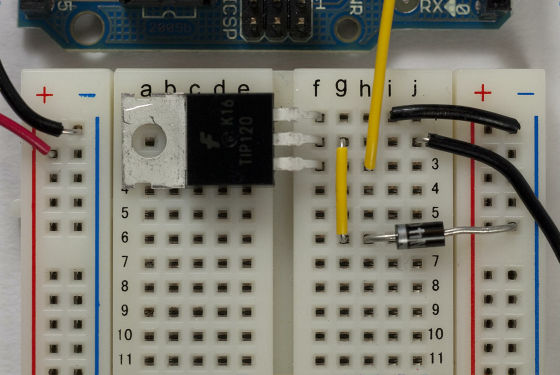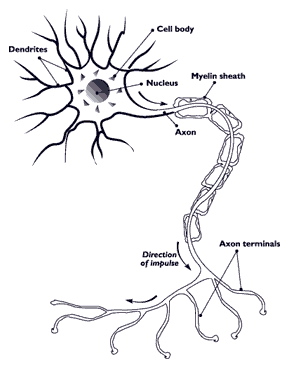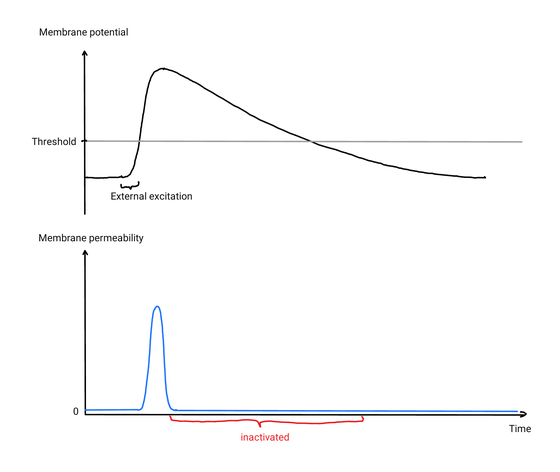How does the nerve communicate information?

ByBryan Jones
Julius Kunze has compiled a blog on how information transmission is carried out about nerves, which are the organs responsible for commands and sensations of the movement of the whole body.
juliuskunze.com/how-to-build-a-brain
http://juliuskunze.com/how-to-build-a-brain
In thinking about the mechanism of the nerve, let's first think about how the computer works. The computer is made up of transistors as a basic processing device and wiring between them. A transistor is a switch that has an on or off state, by combining it, logic and arithmetic operations are enabled, and the program can be operated. The integrated circuit is a connection of a large number of fine transistors.

ByDustyn Roberts
On the other hand, let's consider how the transmission and basic processing parts in the brain work.
First of all, a method for exchanging information "Communication of information by chemical substancesFrom. Transmission of information by chemical substances has a slow spreading rate, so it will not be practical if the number of cells through which signals pass is multiple. Also, since all cells along the transmission path receive the same chemical substance, the type of message that can be sent is limited by the number of chemicals and receptors. However, it is useful when there is no problem even if the transmission speed of information is sufficiently low, and in fact human beings are also exchanging information such as digestion, blood pressure, immunity etc. with information transmission by hundreds of hormones.
next"Information transmission by electricity"about. Since the brain is made of cells, it is a simple idea to use cells as conductors and cell membranes as insulators. However, the following problems occur.
· Since extracellular fluid is similar to dilute seawater and insulation is an important issue because of its high conductivity, the electrical resistance of the cell membrane is about 1 million times lower than rubber.
·Nerve fiberThe resistivity of the fluid in the nucleus of the nucleus is about 100 times higher than copper.
Nerve fibers are usually about 1 μm in diameter and have a cross sectional area of about one millionth of the copper wire.

Therefore, cells can transmit signals at distances of only a few mm at most. Therefore, it becomes necessary to amplify the signal at regular intervals. When amplifying the signal, it becomes possible to transmit to a certain distance, but if noise is added at the time of amplification it will not know how strong the original signal was. Therefore, if a protocol focusing only on "whether or not a signal has been sent" is used, "If the received signal is stronger than a certain level, it issues a signal" or "If the received signal is less than a certain strength, it does not signal It is possible to make a signal system resistant to noise using a repeater that works like "
Let's consider how to implement such a repeater. One way is to inject ions from the outside of the cell with the ion pump into the nerve fiber and increase the current in the nerve fiber when receiving more than a certain signal. However, in order to realize this, there is a condition that "the ion pump must respond quickly and quickly" and it requires a very flexible energy supply source,ATPaseIt is difficult to utilize established mechanisms like.
Therefore, instead of injecting ions after receiving a signal, it is conceivable to eject ions in nerve fibers with an ion pump in advance. If you open the ion channel at the timing of receiving the signal, ions can be brought in quickly due to the concentration difference. If we think that the discharge of ions is slow, we can supply energy through ATPase etc.
By using the above method, it is possible to shorten the sense from input to output. Next, let's consider a method to end output. So, Julius's thought for the moment,
- The nerve fiber which received the input opens the ion channel and fills the inside of the fiber rapidly with ions, but immediately closes the channel.
· By doing so, ions are discharged again slowly.
· In the end you will be able to receive input again.
something like. I repeat this cycle to exchange information. How much the ion channel opens with the strength of the signal varies, but since there are many ion channels, the stronger the signal strength, the more probably the number of ion channels that will open will increase.

Of course, in the above method, the amount of information that can be passed is proportional to the rate that the sodium ion pump takes to drain sodium ions, but the signal has a long period of time and is completely below the ion channel threshold It takes time. Therefore, we will use potassium ion anew this time. Sodium ions are discharged beforehand and at the same time, potassium ions are taken in. When the signal is input, the potassium ion channel opens somewhat behind the sodium ion channel and the potassium ion leaks. By doing so you can quickly lower the potential, the possibility of restarting the ion channel is reduced, and the time to inactivation can be shortened. This actually happens in the body.

The figure below is a schematic representation of nerve cells. The part that receives input in the upper halfDendrite(dendrites), do output belowNerve fiber(axon) is drawn, and the dendrite includes a large number of connection points with other neuronsSynapse(synapse) is sticking. Also, in the center is the juncture point between the axon of the nerve fiber and the dendriteCell body(soma). Information transmission by potential change using sodium or potassium is used in this nerve cell interaction.

By Amyleesterling (Own work) [CC BY-SA 4.0],via Wikimedia Commons
Because nerve fibers need to transmit information quickly while not being very good in conductivity and insulation, we work with such a very complicated mechanism. Due to the achievement of discovery of this sodium-potassium pump, in 1997Jens SkovaThe Nobel Prize for Chemistry is awarded.
Related Posts:
in Science, Posted by log1d_ts







